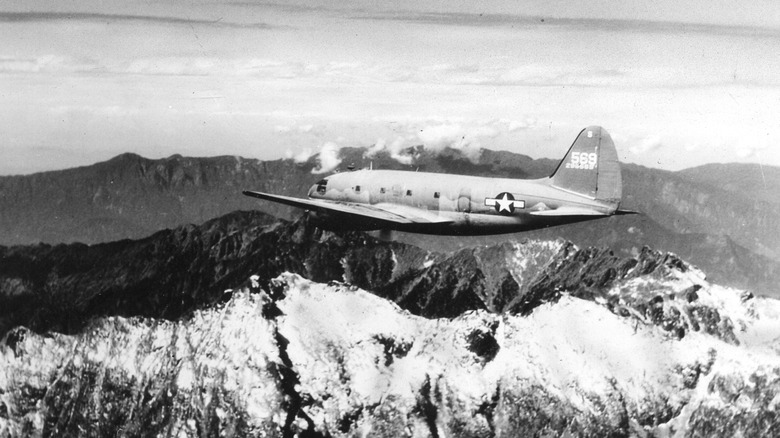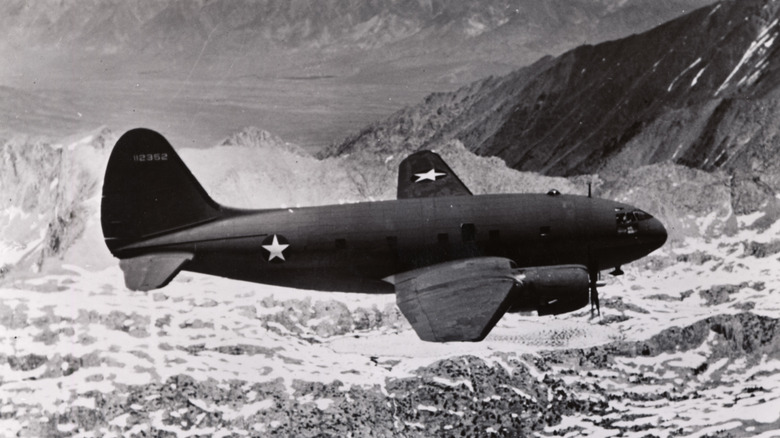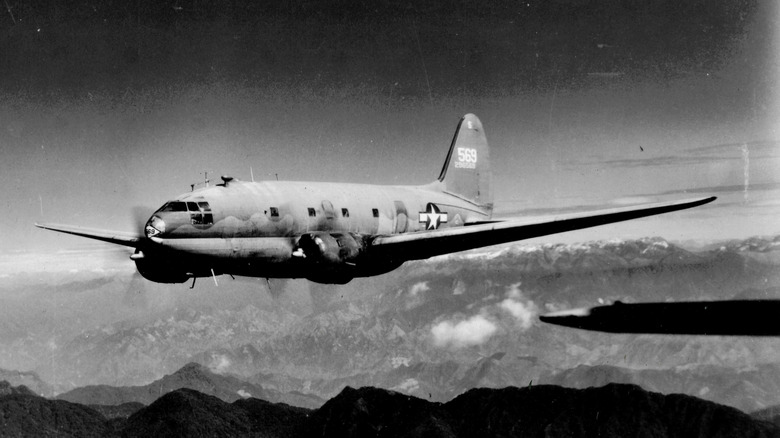What Was 'Flying The Hump' In WW2?
Many of the most legendary battles of World War II were directly shaped by the actions of pilots, with several crucial battles fought almost entirely in the skies. For example, at least nine different aircraft fought in the Battle of Britain. Planes launched from aircraft carriers also served a crucial role in bringing the United States to victory in the Battle of Midway in the Pacific. In addition to dropping payloads of bombs on the enemy, aircraft were also used to transport supplies and equipment.
The vital service that military cargo aircraft and their crews provided by moving supplies to the front lines of the war may have been less glamorous, but it was no less important than the more direct combat roles. When it comes to airlift operations, perhaps none was more impressive — or more dangerous — than the U.S. Army Air Force's "Flying the Hump" campaign in the China-Burma-India Theater between 1942 and 1945. This risky maneuver involved flying cargo from bases in India up and over the towering Himalaya mountains to Allied troops fighting Japanese forces in China.
Aviators had to navigate the Himalayas to deliver supplies
Prior to 1942, the famed Burma Road was the primary means of getting vital fuel and other supplies into western China, where combined U.S. and Chinese forces were engaged with the Imperial Japanese Army. In the spring of 1942, the Japanese had occupied Burma (now Myanmar), including the Burma Road, which cut off this vital Allied supply line into China. With the ground route cut off, the U.S. Army Air Force was called upon to move supplies from India into China via cargo aircraft.
This wasn't just any simple air cargo route. Flying into China would require flying from 100 feet above sea level to up to 18,000 feet over a portion of the Himalayas, the world's tallest mountain range (hence the name, "Flying the Hump"). Today, the airport near the Himalayas remains the most dangerous in the world, and only certain planes are allowed to fly there. Flying an aircraft in the 1940s in this region was even more challenging without the aid of modern technology. With less powerful, lower-flying prop-driven aircraft and primitive navigation gadgets, the crews flying the route needed to be tremendously skilled to get their heavy loads over the mountains.
Initially, most of the flights were performed by the venerable Douglas DC-3 or its military counterpart the C-47 Skytrain. Then, the more powerful Curtiss C-46 Commando arrived in 1943. Capable of flying heavier loads than the C-47, the C-46 (nicknamed "Ol Dumbo") would become legendary for flying missions over the Hump.
'Flying the Hump' came with great risks
If the mountains themselves weren't challenging enough, the weather over "the Hump" really upped the risk. Conditions could change rapidly with the terrain, with 100-mph winds, blizzards, extreme turbulence, and both dust and monsoon storms all being commonplace. What was typically supposed to be a three-hour flight could become a 10-hour one as planes were forced to navigate around severe weather conditions and towering terrain — all before arriving to the looming threat of Japanese fighters on the other side.
Despite these conditions, over 450,000 flights were made in this region between 1943 and 1945, with over 685,000 tons of military supplies delivered during that time. However, this success came at a price. Over 500 crashes and more than 1,300 crew members died during these treacherous missions. The brave pilots who flew these lumbering cargo planes over India and China might not have the same level of fame and recognition as the ones who flew the iconic Boeing B-17 Flying Fortress over Europe, but they are every bit as deserving of a place among World War II's great aviators.


